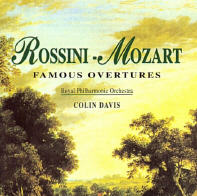| Price: |
When one considers that the first overtures to be written around 1600 consisted of little more than a fanfare or two plus a few linking notes, the whole thing over in half a minute, their development and diversity by Mozart's time, and even more by Rossini's, is astonishing. Each one of Rossini's overtures is quite distinct, though almost without exception they contain his 'fingerprint', the rousing orchestral crescendo. The exception is the overture to his last opera, Guillaume Tell. It falls into four parts: a beautiful introduction featuring a cello quintet, a storm sequence, a pastorale, and the famous final galop. La Gazza Ladra (in which a magpie steals jewellery and a servant girl gets the blame) and Semiramide are major symphonic movements, while Il Signor Bruschino is notable for its short duration and the odd rhythmic effect of the violinists tapping bows on their music-stands. Finally, L'Italiana in Algeri borrows a trick from Haydn's 'Surprise' Symphony with a stealthy opening and a sudden chord. Someone once remarked that this is a picture of a husband arriving home late and failing over the cat!
Perhaps Le Nozze di Figaro is Mozart's best-loved overture: jolly and tuneful, it's called the ''egg-timer' because it plays for as long as it takes to boil one. Die Zauberflöte is more serious in tone but the ascending flute scales relieve the atmosphere of mysticism created by Mozart's use of three trombones to add weight to the Masonic subject. Three groups of developing chords give a pause for breath half-way through. Don Giovanni has an intensely dramatic opening, as befits the tragic opera it was designed to precede. The doom-laden chords herald the grim statue scene, while the Molto Allegro suggest the Don's uncaring exploits.
Robert Dearling.
Discontinued
|

